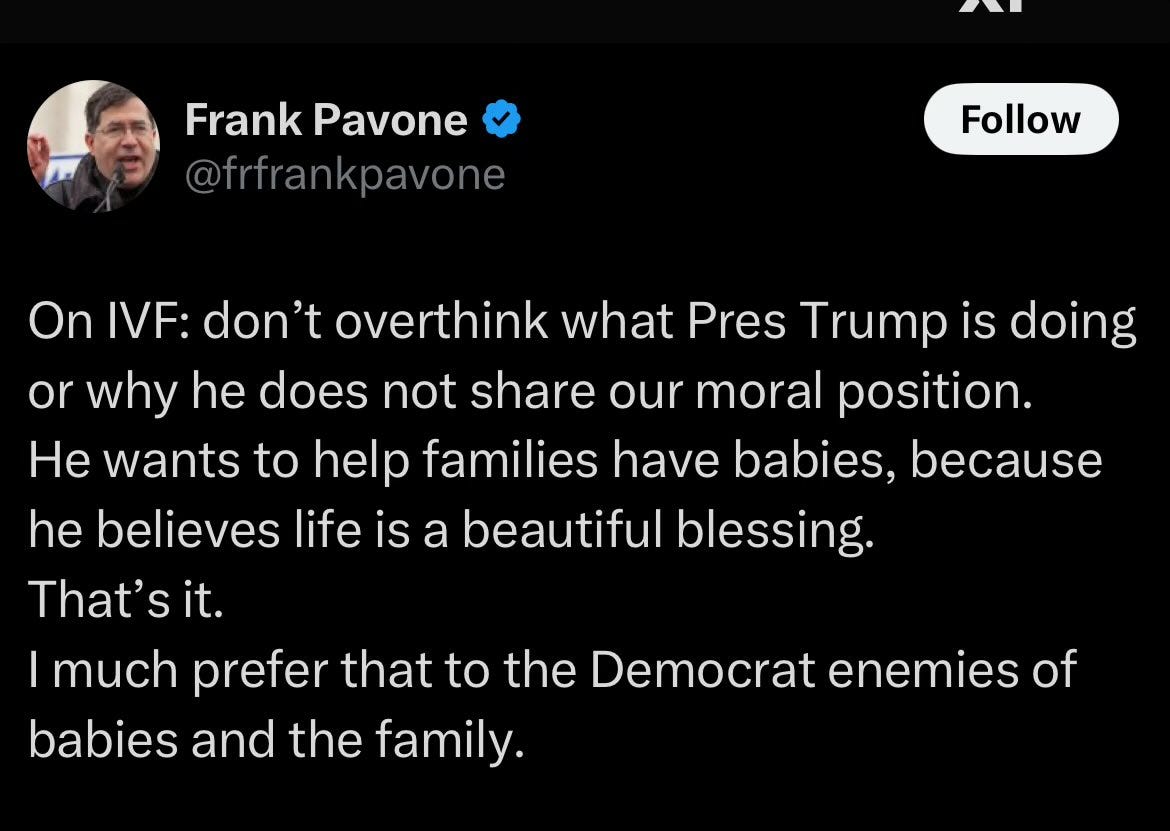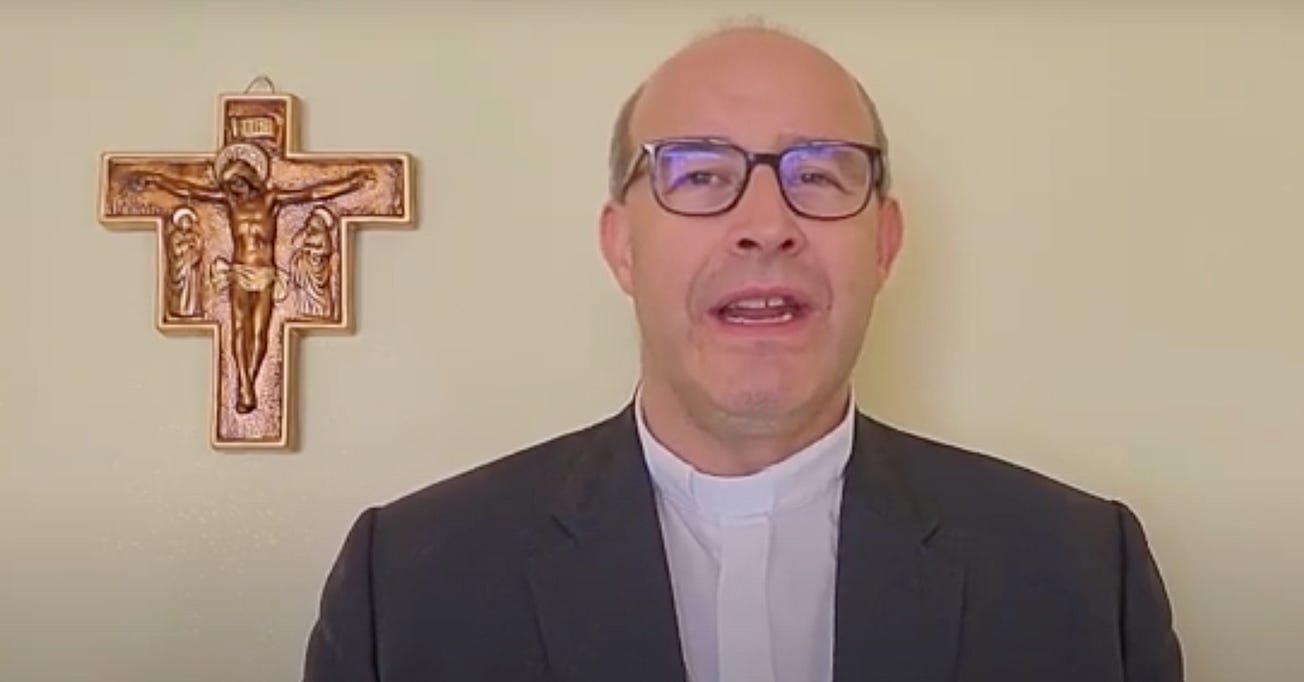Pillar subscribers can listen to Ed read this Pillar Post here: The Pillar TL;DR
Happy Friday friends,
Pope Francis’ health continues to be a major concern for everyone in the Church.
It’s now been a week since his respiratory affliction took him into hospital. I am certainly encouraged that he seems to be responding well enough to treatment that the noises out of the Vatican have stopped getting more negative, though the reality is an 88-year old who spends much time in a hospital faces a hard road to full recovery.
Assuming Francis returns to work soon, as we should all pray he is able to, it seems likely we’ll be entering a new normal for the pope and his schedule.
The welfare — indeed the very life — of the Bishop of Rome is of immediate import to all Catholics. Of course it is. But I have been keenly struck by the frenetic “papal death watch” style of coverage we have seen. Even if the interest is understandable and at its core sincere, it has a grisly tone to it.
Rereading the relevant canon law for the illness and possible death of a pope, I was also struck by certain provisions meant to protect the dignity and privacy of a pope in his final days, whenever they arrive.
“No one is permitted to use any means whatsoever in order to photograph or film the Supreme Pontiff either on his sickbed or after death, or to record his words for subsequent reproduction,” according to the Apostolic constitution Universi Domenici Gregis.
“If after the pope's death anyone should wish to take photographs of him for documentary purposes, he must ask permission from the Cardinal Camerlengo of Holy Roman Church, who will not however permit the taking of photographs of the Supreme Pontiff except attired in pontifical vestments.”
Such prohibitions are not, I would suggest, purely or even primarily about preserving the dignity of the pontifical office, though for obvious reasons that is a concern.
More important, I think, is the need to respect the privacy of Francis (and indeed any pope) in his final days and moments. It is for a reason that, as part of the traditional assessment of a papal death, the pope’s baptismal, not regnal, name is called.
Even the pope dies as a simple soul, a Christian going forth in faith to meet its maker and in hope of an encounter with the all conquering love of the risen Christ.
But that process, for even a saint, can be fraught with moments of pain and fear and even doubt — indeed it is my understanding that the more holy the soul the more acute are the attacks of the devil in their final days. Every Christian deserves, and is owed by the Church, the space to make their way to God in freedom, supported by our prayers and the sacraments, but shielded from the need to perform or offer to us some spectacle.
I hope and pray Pope Francis will recover and return to his ministry. But as he struggles now, we should also all pray most fervently for the soul of Jorge Mario, our brother in Christ.
That is the debt of fraternal love we owe him, as much as any obligations of filial devotion to the office he holds.
Here’s the news.
The News
So, full disclosure, I took a day off yesterday to spend with some family who are in town. Which was delightful.
Imagine, though, my surprise to discover JD used my absence to declare a “fire sale” on Pillar subscriptions. He seems to think this is a kind of hilarious joke at my [admittedly neurotic] expense, which I would find funnier if my landlord also offered a year’s tenancy for nine months’ rent. But he doesn’t.
Anyway, in the interests of making the best of an unexpected situation, I’ve agreed to unlock today’s Starting Seven — Luke’s peerless morning news round up of everything worth reading in the life of the Church, at The Pillar and elsewhere.
Starting Seven is normally for paid subscribers only, who can get it in their inbox every day of the working week, well before most people make it into the office.
Enjoy.
And if you’d like the chance to read it again Monday, it’s simple and for today only, thanks to JD, 25% off.
Overthink it, please
President Donald Trump signed an executive order on Tuesday instructing the development of policies to expand access and funding for invitro fertilization.
I hope I need hardly say I am against this, since it is simple science that the procedure involves the willful creation and necessary destruction of embryonic human life on an industrial scale, and because the Church has always rightly condemned it as a grave violation of human dignity, that natural law, and the Divine cooperation in and institution of the marital act.
The president’s pro-IVF stance was announced and pitched during the campaign as a “pro-children, pro-family” policy. And, to be clear, the executive order does nothing substantial for the moment — it only paves the way for some potential policy options. So we may not see, as some fear, a Little Sisters of the Poor Mandate II: IVF Boogaloo.
Indeed, we may not see anything substantial at all, for all we know the administration may just use IVF as a kind of signalling topic of conversation without ever moving any concrete policy. Who knows?
But it’s the bundling together of being pro-IVF with pro-children and pro-family that I think needs to be challenged more directly — and which Trump’s most self-ascribedly “pro-life” supporters seem intent on looking away from.
Consider the advice of former-father Frank Pavone, the laicized leader of “Priests for Life:”
“Don’t overthink this” is, I’d say, the major argument for pretty much any anti-life cause you could name. And with IVF, not overthinking it is exactly the problem.
The science of IVF is clear on its treatment, by necessity, of human life as a kind of usable and disposable commodity.
And even more fundamentally, even if the process could be perfected to the point that no destruction of life was involved, there is no real distinction here, in fact or in the mind of the Church, between the objections to IVF and artificial contraception.
Both seek to hive off the unitive from procreative aspects of conception, denigrating both and parting us from the Divine intent that we be joyfully cooperators in— not the objective masters of — the creation of new life.
But all this is a reality lost on many people, which is why VP JD Vance could say last year, I believe sincerely, that he knows a lot of couples who have made recourse to IVF in pursuit of their understandable yearning to have children, and try to defend the practice as “pro-family” and “pro-children.”
Cards on the table, I get that. To a degree. I also know couples who have children that resulted from IVF. And their painful experience of longing for children is not alien to me — not at all.
My wife and I waited a decade and a half to become parents, with little or no prospect of that happening, while being offered virtually zero by the medical profession in the way of infertility diagnostics and treatment beyond “You can try IVF, and if you don’t want to, you clearly aren’t that desperate for kids.”
And even apart from the heartache we went through, watching our extended circle of family and friends blossom and grow — even watching “kids” we used to babysit become parents themselves — there was the real sense of suspicion and shame we felt in some corners of our own Catholic social circle.
The number of people who, on first acquaintance, would ask how many kids we had and how long we’d been married and then cock us an eyebrow was higher than you’d imagine — as were the number of times I was quietly pulled aside by a well meaning Catholic dad so he could patiently explain to me the joys of being open to life.
I say this all to make clear that there’s a lot we tend not to “overthink” when it comes to life and children, and there’s only ground to be lost by shaming and shrilling about why IVF is, most definitely, anti-life.
There needs to be a serious push to deep-think IVF among the pro-life movement and a real and a really sensitive approach to the conversation, one which loves and supports and persuades people who will be tempted — and as we can see positively exhorted — to not “overthink” the issue.
There are a lot of people who have been sold a mechanistic and utilitarian vision of what being “pro-child” means. They aren’t the bad guys here. They are often friends and neighbors and loved ones.
But there are other people who are pushing that vision, sometimes out of ignorance, and sometimes as part of a political calculus that reduces being pro-life to “moods and vibes.”
Life is more than that.
ASMR, WFT?
There’s a lot I don’t know. And, despite my professional experience with the limitations of “legacy media,” a lot I take on trust when it pops up in a newspaper I respect.
So, last night, as I was flipping through The Times, I saw an “article” about Hermes neckties which I thought I’d give a read — I don’t sleep much or well, and I often have to bore myself into oblivion to quiet the dozen things spinning in my head which threaten to drive me back to my desk in the middle of the night.
I don’t own any Hermes ties, to be clear. And I have no desire to. Haute couture doesn’t interest me at all. But I do take a casual pleasure in well made things, and I am one of those fogyish holdouts who feels naked without a necktie.
Blame my education; if you have to wear a tie every day from the age of nine, and if you're punished for not wearing it right, it creates a habit and a reflexive comfort in the routine.
So when I saw the headline “Where luxury meets ASMR: Hermès tie,” I thought: “Neckties? Sure I’ll read that.”
Imagine my confusion, then, to discover the “article” was two paragraphs long, ending with this sentence, “Watch the calming motions of a tie being tied,” and a video of… a headless man tying a tie with the mic turned up to 11.
I was flummoxed. I reread the article. No help. I reread the headline and conceded I had no idea what ASMR meant, so I read the article again (all two paragraphs of it) and found no reference to this novel acronym.
What did it mean? What was this weird video about? I assumed it must be some industry term for high craftsmanship. But, thanks to a swift Google, I soon learned it is short for “autonomous sensory meridian response,” which describes, and I am not dumbing this down, it’s the actual meaning, “that tingling sensation you sometimes get when you hear a noise.”
Apparently there is a whole cottage industry of YouTubers and such who make a living filming, with extreme hi-def sound, someone whispering, paper being crumpled, and fabric swishing just to give people some goosebumps, because a lot of people find it relaxing and “therapeutic.”
Who knew?
Given the lofty, scientific sounding name for the thing, and the fact that it was popping up in The Times, the world paper of record, I assumed that there had to be some interesting neuroscience behind all of this, so I went hunting.
Imagine my surprise to discover that the term “autonomous sensory meridian response” isn’t medical or even clinical in origin. It was coined by a woman who started a Facebook group in 2010 dedicated to noises that give people the willies, in a nice way.
I’m frankly at a bit a loss about the whole thing. I mean, if hundreds of thousands of people want to tune in to watch someone click their nail extensions and whisper plosive consonants into a microphone, I suppose that’s in the realm of “really weird but mostly harmless,” question mark?
But really I think there’s something deeply sinister about a whole pseudo-therapeutic culture and vocabulary springing up around a thing, and that it can be so pervasive and popular it shows up in The Times without explanation or comment.
That can’t be right, or good, can it? I mean, for sure some of this stuff does give you the willies, so there must be some kind of sensory neurology at play here — and we shouldn’t just play around with that. Right?
Am I crazy here?
See you next week,
Ed. Condon
Editor
The Pillar





